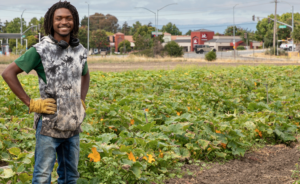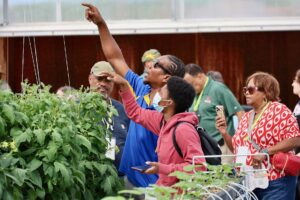Food banks that run or support farms with a cultural mission are reaping more than just crops.
At food-bank farms, cultural awareness can take on many forms: The farms may be focused on supporting Black, Indigenous and People of Color (BIPOC), or helping to create a sense of community among immigrant populations. In one case, a food-bank farm is seeking to uphold ancient agricultural practices of the desert region.
No matter their specific intent, culturally aware farms position food banks to strengthen community connections and support their neighbors in ways that go beyond tackling food insecurity. While many of these initiatives have been around for a few years, their profile is rising at a time when institutions are being called on to support communities in more equitable ways.
“Food banks across the nation should really be partnering with local BIPOC community-based farm organizations that can reach the people that maybe they can’t reach,” said Shantae Johnson, who co-founded the Black-led farming organization Mudbone Grown in Portland, OR, along with her partner Arthur Shavers, in 2016.
In 2017, the Mudbone farming enterprise gained greater footing when it formed a partnership with Oregon Food Bank. The food bank acts as Mudbone’s fiscal sponsor and also supplied land near its headquarters to develop Unity Farm, a learning and community farm managed by Mudbone. In addition to grant writers, the food bank has provided a network of food industry connections and support that has helped give a new platform to the work Johnson and Shavers have been doing.
“As new farmers, it was amazing to be just even associated with the Oregon Food Bank,” Johnson said. “That credibility, I believe, has helped to get us into doors that maybe we wouldn’t otherwise been able to.”
With the help of the food bank’s grant writers, Mudbone was able to secure a USDA grant that enabled it to start Pathways to Farming, a three-year incubator program designed to help farmers of color launch agricultural businesses. The program is currently in its second year and is working with 13 farmers.
Johnson cited Mudbone’s work with the food bank as also helping it secure partnerships with the county. Most recently, the food bank provided donations to Mudbone’s eight-week Covid-19 relief program for Black families. “They are trusting Black leadership and they continue to show up for us,” Johnson said of Oregon Food Bank.
Collaborations are also at the center of the Community Food Bank of Southern Arizona’s farming efforts, which seek to create greater economic and nutritional sustainability in its community.
The food bank offers training, supplies, greenhouse access, land and low-cost tools for people looking to grow food, either on its seven-acre farm or in their own yards. As participants from other countries have shared their agricultural backgrounds, the farming and gardening programs have become a site for cultural exchanges.
“We’ve had more refugees come, join and teach us about their farming practices, their culture and how they farm their deserts because we’re in a desert region,” said Claudio Rodriguez, the food bank’s Farm and Garden Program Manager. Now the food bank is expanding the languages that its farming workshops are available in beyond English and Spanish, in an effort to support greater language justice.
These small farmers and backyard gardeners go on to make up the food bank’s Abundant Harvest Cooperative program, which allows them to sell their harvested products at a shared farmer’s market table. “As people learn and advocate on their skills, they can connect with other businesses who would like to buy their products,” Rodriguez said.
The food bank’s small farming and backyard gardening programs are now among its most active initiatives, helping to bolster both food and nutritional security, especially during the pandemic.
“I wouldn’t say that they’re exciting times, but they’re really interesting times in terms of people becoming more interested in growing their own food,” Rodgriguez said. “When they began to see their grocery store shelves start to go empty, it was really a turning point, at least for us, that we started to get more demand.”

In Texas, farming has provided San Antonio Food Bank with a rare opportunity to address nutrition, while also highlighting the city’s historical farming traditions.
Through a partnership with the National Park Service, the food bank manages 45 acres of farmland surrounding Mission San Juan, a centuries old Spanish settlement, while teaching volunteers about its 300-year-old acequias, the ancient irrigation system used by the mission’s original inhabitants. In fiscal 2019, the Mission San Juan Farm produced about 40,000 pounds of stone fruit and about 30,000 pounds of onions.
A demonstration farm, covering an additional five acres, exclusively uses the original flooding methods of the mission, while also showcasing historical planting methods, such as the Native American three sisters growing technique.
The farms have allowed the food bank to expand its farming and mobile food pantry team to include eight full time jobs, with six being on the farming team. In addition, the food bank averages about 300 farm volunteers a month (pre-Covid) to help out on the farms.
“A lot of people that live their whole life in an inner city, when they get to come out and be on a farm … they’re happy to pick up and learn something,” said Darron Gaus, Farm Manager.
He added, “What’s kind of cool is that a lot of people get to see all this farming and donors get to see it, they get excited about it and help us out,” Gaus said. “When that monetary help grows, then we get to expand a little bit more.” — Feven Merid
Feven Merid is a freelance reporter and recent graduate of Columbia’s School of Journalism Master’s Program where she specialized in print and audio. Feven has previously been published in Documented, The Uptowner and Columbia University’s Library Podcasts.
CAPTION ABOVE: Arthur Shavers and Shantae Johnson run the Mudbone Grown farming enterprise, which Oregon Food Bank helps to support.
Want to solve hunger? Support Food Bank News in empowering food banks with best practices information about hunger relief.
Support Food Bank News













